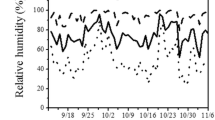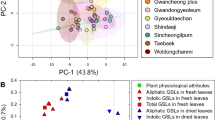Abstract
Eight species belonging to the Family Cruciferae were classified to lafminer resistant, tolerant and susceptible on the basis of leafminer infestation. They were analyzed for the glucosinolate content and correlated with leafminer infestation.
Total glucosinolate content in general and sinigrin content in particular appeared to have the ability to repel the attack ofLiriomyza brassicae, while gluconapin appeared to attract them. The percentage of infestation, the number of mines and the number of living larvae were estimated for evaluating the glucosinolate efficacy againstL. brassicae on cabbage.
Similar content being viewed by others
References
Abdalla, E. F.; Abdallah, S. A.; Sammor, E. A., 1992: Evaluation of certain insecticides for control of pea leafminer,Phytomyza atricornis (Meigen) with notes about its significance. African J. of Agric. Sci. (in press).
Abdel-Salam, A. M. E., 1993: Toxicological studies on broad bean fly,Liriomyza trifolii (Burgess) and surveying the pests infesting broad bean (Vicia faba L.). M. Sc. Thesis, Cairo Univ., Faculty of Agric. pp. 130.
Darvas, B.;Andersen, A., 1996:Chromatomyia fuscula (Zett.) (Diptera: Agromyzidae) host plant, feeding and oviposition site preferences. J. Appl. Ent.120, 23–27.
Duncan, D. B., 1955: Multiple range and multiple F-test. Biometrics, 11–42.
El-Serwy, S. A., 1996: Evaluation of certain wheat varieties for susceptibility to infestation with the leafminerAgromyza nigripes (Meigen) (Diptera: Agromyzidae) and grain yield at El-Gemmeiza and Sids Regions. Bull. Ent. Soc. Egypt.74, 139–148.
Erickson, J. M.;Feeny, P., 1974: Sinigrin: a chemical barrier to the black swallow tail butterfly,Papilio polyxenes (Lep., Papilionidae). Ecology55, 103–111.
Harborne, J. B., 1973: Phytochemical methods, Chapman & Hail LTD. New York, pp. 269.
Hendreson, C. F.;Tilton, E. W., 1955: Tests with acaricides against the Brown wheat mite. J. Econ. Entomol.48, 157–161.
Josefsson, E.;Muhlenberg, C., 1968: Glucosinolates in seed of Swedish Brassica crops. Acta Agric. Scand.18, 97–100.
Knapp, J.; Pena, J.; Stansly, P.; Heppner, J.; Yang, Y., 1994: The citrus leafminer,Phyllocnistis citrella, a new pest of citrus in Florida. Florida Cooperative Extension Service Ins. Food & Agric. Sci. Univ. of Florida pp. 1–4.
Kogan, M.; Paxton, J., 1983: Naturial inductors of plant resistance to insects. American Chemical Society 153–171.
Lichtenstein, E. P.;Strong, F. M.;Morgan, D. G., 1962: Identification of 2-phenylethylisothiocyanates as an insecticide occurring naturally in the edible part of turnips. J. Agric. Food Chem.10, 30–33.
Lichtenstein, E. P.;Morgan, D. G.;Mueller, C. H., 1964: Naturally occurring insecticides in cruciferous crops. J. Agric. Food Chem.12, 158–161.
Malik, R. S.;Anand, I. J.;Srinivasachar, D., 1983: Effect of glucosinolates in relation to aphid (Lipaphis erysimi Kalt.) fecundity in crucifers. Intern. J. Trop. Agric.4 (1), 273–278.
Rygg, T.;Somme, L., 1972: Oviposition and larval development ofHylemya floralis (Fallen) (Dip., Anthomyiidae) on varieties of sweeds (B. napus) and turnips (B. rapa). Norsk. Entomol. Tidsskr.19, 81–90.
Sanderson, K. C.;Oetting, R. D.;Smith, D. A., 1989: In—transit neem insecticide treatment of rooted chrysanthemum cuttings controls leafminer. Hort. Science24 (5), 856.
Stem, U.;Parrella, M. P., 1985: Seed extract shows promise in leafminer control. California Agriculture39 (718), 19–20.
Tjallingh, W. F., 1976: A preliminary study of host selection and acceptance behaviour in the cabbage aphid,Breviceryne brassicae L.. Symp. Biol. Hung.16, 283–285.
Verschaeffelt, E., 1910: The cause determining the selection of food in some herbivorous insects. Proc. Acad. Sci. Amsterdam13, 536–542.
Virtanen, A. I., 1965: Studies on organic sulphure compounds and other abile substances in plants. Phytochem.4, 267–288.
Wetter, L. R.;Youngs, C. C., 1976: A thiourea—UV assay for total glucosinolate content in rapeseed meals. J. An. Oil Chemist's Soc.53, 162–64.
Author information
Authors and Affiliations
Rights and permissions
About this article
Cite this article
Abdel, I., Ismail, K. Impact of glucosinolate in relation to leafminer,Liriomyza brassicae Riley (Diptera: Agromyzidae) infestation in crucifers. Anz. Schadlingskde., Pflanzenschutz, Umweltschutz 72, 104–106 (1999). https://doi.org/10.1007/BF02768919
Issue Date:
DOI: https://doi.org/10.1007/BF02768919




